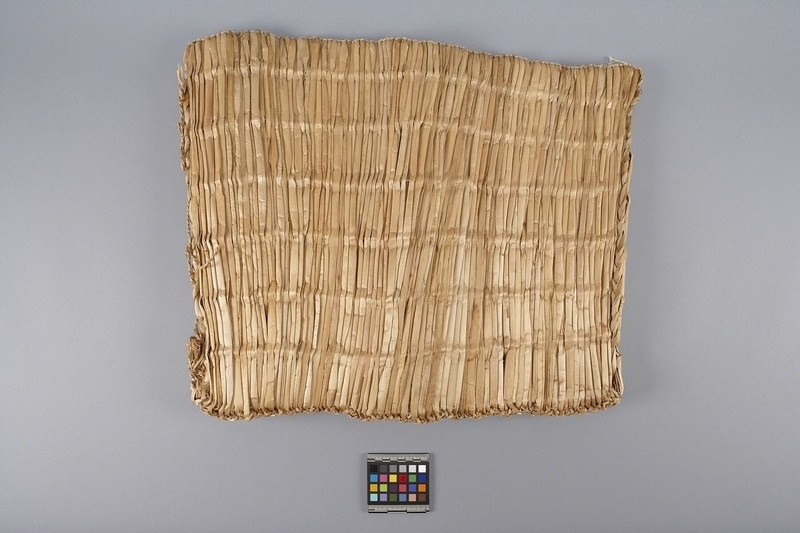Canoe Mat Item Number: A9323 from the MOA: University of British Columbia

Description
Small, rectangular mat made from cat-tail reeds woven together with cotton twine. Cat-tail leaves are arranged in horizontal rows, which have been creased before they were woven together. Mat is doubled for thickness.
History Of Use
This mat was reportedly used as a canoe mat. Mats of cattails or tule reed stems were produced by Salish groups. Homer Barnett notes that cat-tail was "an all-purpose fabric and turned the rain very well. In summer, long mats covered the framework of temporary dwellings. In winter, they padded the walls of the plank houses. At all times they were used to sit, to eat, and to sleep on, and as coverings and paddings of various kinds (1955:122). Sizes varied depending on the purpose, and most families would possess a range of sizes.
Cultural Context
shelter; transportation; domestic
Specific Techniques
The leaves used for making cat-tail mats are gathered in the summer, cut to even lengths, dried in the sun on the beach, and then stored until needed. The leaves were layed out side by side, alternating the tops and bottoms, and threaded at 10 cm intervals (See Turner, 1979, p150). The cat-tail mats were then sewn together by passing a long hardwood needle through a series of stems, then crimping the stems over the needle with a coarse wooden creaser to prevent splitting, before drawing the thread through. (By contrast, tule mats are twined together with cordage).
Item History
- Made by Mrs. Bartleman (Maker) in British Columbia, Canada before 1962
- Collected in West Saanich, British Columbia, Canada
- Owned by Edith Bevan Cross before July 30, 1962
- Received from Edith Bevan Cross (Seller) and H. R. MacMillan (Funding source) on July 30, 1962
What
- Name
- Canoe Mat
- Identification Number
- A9323
- Type of Item
- mat
- Material
- cat-tail grass and cotton fibre
- Manufacturing Technique
- threaded and bound
- Overall
- height 49.0 cm, width 61.3 cm, depth 3.3 cm
Who
- Culture
- Coast Salish: Saanich
- Creator
- Mrs. Bartleman (Maker)
- Previous Owner
- Edith Bevan Cross
- Received from
- Edith Bevan Cross (Seller) and H. R. MacMillan (Funding source)
Where
- Holding Institution
- MOA: University of British Columbia
- Made in
- British Columbia, Canada
- Collected in
- West Saanich, British Columbia, Canada
When
- Creation Date
- before 1962
- Ownership Date
- before July 30, 1962
- Acquisition Date
- on July 30, 1962
Other
- Condition
- good
- Accession Number
- 0081/0199